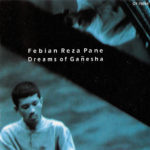
How much are we a product of our past? It’s those thoughts that were floating through pianist Febian Reza Pane’s mind when he created Dreams Of Ganesha. From the first piano note you hear played to the last sustained note your hear ringing, instant memories of the deeply inward “jazz” music of Keith Jarrett start to come into mind. Simply rich with knowledge and feeling, Dreams Of Ganesha perfectly captures a very personal creative journey Febian had to take. It’s nearly an hour-long soundtrack to a very unique kind of self-reflection.
You see, Febian Reza Pane didn’t come to this music easily. For many years, in his Tokyo base, Febian had gravitated towards other kinds of music. Whether it was playing bossa nova, European impressionism, or Latin jazz, as a session musician or solo artist, his own Japanese and Indonesian roots remain hidden underneath his performances. Eventually, in the late ‘80s, he tried to distance himself from that Western, classical training and music.

Working with Hiroki Miyano and others, Febian took his first step outside what he knew, and founded Acoustic Club (a group very similar to Killing Time) that seemed to be under the spell of the Penguin Cafe Orchestra. However, as his own solo career took off, his own side explorations remained there, away from the more “traditional” compositions (by the likes of Erik Satie and known tango standards) favored in his recorded work.
1994, just feels special for Febian. Dreams Of Ganesha was created years after his last work. It appears during this time Febian really went into his own heritage to create something that could speak to who he was as a person.
From his father’s Indonesian side, Febian studied the sonority and tonal qualities of gamelan and Islamic music. Much like Satie, he attempted to bridge that gap within his own technique. From his mother’s Japanese side, that spectral, zen-like quality of his motherland’s folk tradition was tapped to create spaces in his improvisation. Rather than attempt to force Asian instruments into his fusion, he explored how these western instruments he had played for so long, can inhibit that same space. Dreams Of Ganesha sounds so flawless because Febian bended their sound to reflect himself.
Dreams Of Ganesha was the work of a trio. Febian was joined by bassist Yoshino Hiroshi and percussionist Yahiro Tomohiro, both with years of experience backing other forward-thinking Japanese experimentations. Wonderfully contemplative, right off the bat, on the title track we get a sense of what’s coming.
Gingerly dancing around an Indonesian leitmotif, the rest of the trio allows Febian to go deeper and deeper into the tantric, hypnotic percussive improvisation that gamelan music allowed for. Building to an urbane and spiritual keyed in outro, Febian rightfully pulls you through the makings of something special. “Salsare” takes bits of latin music to move along a droplet of music that seems inspired by Japanese minimalism. It’s salsa with an eye to the orient.
Other highlights like “Grazie, Madre” are instantly, emotionally hard-hitting. Under the spell of Yahiro’s simple shaker, something Noh-inspired blossoms into a pining piano mantra that appears to cycle through the contemplative sonorities of Japanese environmental music. Water, wind, and earth sounds all seem to course through Febian’s dreamlike, sustained piano playing until this mantra becomes more than that. On this song, one for his mother, is the promise Japanese jazz always aimed for. “Borobudur” lets you spend six minutes just divining in all this special feeling, with just piano treading that chasm. And then, he just goes in deeper.

On songs like “Resistencia Dos Quilombos” visions of ECM’s Codona start streaming in. Fusion that starts to approximate not just respect but also of integration of them, within one’s own ideas. I’ll end this review of this masterpiece, because it truly is one, by noting my favorite two-fer: “Memories Of Taketomi-Jima” and “For Your Peaceful Night”.
Strident, jubilant, a bit further away from the more ruminative “blues” of the others, those two remind me of those moments us city folk forget — of those in some far countryside, out in nature, where nothing but our own notes and those of the earth is all the soundtrack we need. On the first, that oceanic piano sustain now gets a percussive heft that Yoshino’s nostalgic bass playing can’t help but infer.
A paean to one of Japan’s most preserved islands gets something that approximates the breezy power of holding on to some tradition. Even as synth swells appear out of nowhere, they dream up something far more tender, that belongs, that’s an important piece that had to be just there. The album reminds you at the end, to no end, on the final track, to not fear what you are, but to see that you are at the center of the universe, that it’s this where you must expand outward from.
